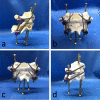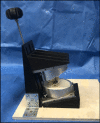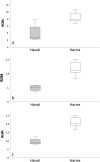Improving stability of atlantoaxial fusion: a biomechanical study
- PMID: 36544078
- PMCID: PMC10368542
- DOI: 10.1007/s00590-022-03465-y
Improving stability of atlantoaxial fusion: a biomechanical study
Abstract
Purpose: The incidence of atlanto-axial injuries is continuously increasing and often requires surgical treatment. Recently, Harati developed a new procedure combining polyaxial transarticular screws with polyaxial atlas massae lateralis screws via a rod system with promising clinical results, yet biomechanical data is lacking. This biomechanical study consequently aims to evaluate the properties of the Harati technique.
Methods: Two groups, each consisting of 7 cervical vertebral segments (C1/2), were formed and provided with a dens axis type 2 fracture according to Alonzo. One group was treated with the Harms and the other with the Harati technique. The specimen was loaded via a lever arm to simulate extension, flexion, lateral flexion and rotation. For statistical analysis, dislocation (°) was measured and compared.
Results: For extension and flexion, the Harati technique displayed a mean dislocation of 4.12° ± 2.36° and the Harms technique of 8.48° ± 1.49° (p < 0.01). For lateral flexion, the dislocation was 0.57° ± 0.30° for the Harati and 1.19° ± 0.25° for the Harms group (p < 0.01). The mean dislocation for rotation was 1.09° ± 0.48° for the Harati and 2.10° ± 0.31° for the Harms group (p < 0.01). No implant failure occurred.
Conclusion: This study found a significant increase in biomechanical stability of the Harati technique when compared to the technique by Harms et al. Consequently, this novel technique can be regarded as a promising alternative for the treatment of atlanto-axial instabilities.
Keywords: Atlantoaxial instability; Biomechanics; Cervical fracture; Cervical spondylodesis; Odontoid fracture.
© 2022. The Author(s).
Conflict of interest statement
Adrian Cavalcanti Kußmaul received financial support from the FöFoLe research grant of the Ludwig-Maximilians-University Munich. All other authors have no conflict of interest.
Figures





References
-
- Jeanmonod R, Varacallo M. Geriatric cervical spine injury. Treasure Island (FL) St. Petersburg: StatPearls; 2020. - PubMed
MeSH terms
Supplementary concepts
Grants and funding
LinkOut - more resources
Full Text Sources

